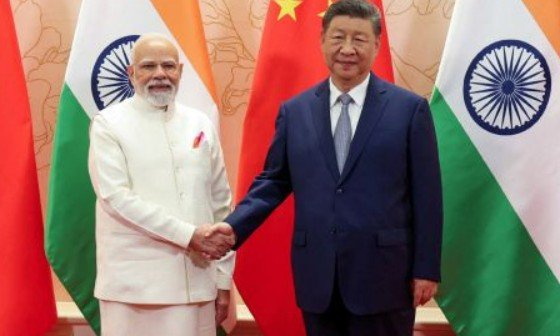Prime Minister Narendra Modi’s Tianjin Reset has drawn global attention, not only for its optics but also for its potential impact on India–China relations. His visit comes at a time of heightened geopolitical flux, where New Delhi and Beijing remain locked in competition over trade routes, technology, and regional influence. While the reset signals an attempt to recalibrate ties, the deeper question is whether it can move beyond symbolism to address the hard realities shaping Asia’s two biggest powers.
Why Optics Alone Won’t Rewire India–China Strategy
Public handshakes and resumed flights in Tianjin buy breathing space — but recent combat incidents, UN deadlock and upstream dams point to deeper, structural divergences.
On the margins of the Shanghai Cooperation Organisation summit in Tianjin, Prime Minister Narendra Modi and President Xi Jinping offered a familiar diplomatic tableau: smiles, symbolic gestures and a joint emphasis on restoring stability. The two leaders announced that direct passenger flights between India and China would resume, and both underlined a pragmatic intent to keep bilateral ties on an even keel. For investors, traders and diplomats, that short-term stability mattered: supply chains and people-to-people links badly needed breathing space after months of geopolitical anxiety.
Yet a photograph and a press release cannot, on their own, rewrite strategic realities that have already shifted. The months leading up to Tianjin witnessed a concatenation of operational shocks, diplomatic bottlenecks and upstream infrastructure moves that together have hardened New Delhi’s threat calculus. Unless the ritual of summitry is followed quickly by verified, technical deliverables, the goodwill from Tianjin risks remaining cosmetic.
what changed before Tianjin — and why it matters
In early May, an aerial engagement exposed a new fact: Chinese-origin long-range missiles were employed in a regional theatre by a third party. That encounter forced Indian pilots into emergency ejections and accelerated a painful reassessment of doctrine, procurement and intelligence assumptions. Around the same period, India launched Operation SINDOOR in response to a terror attack. Senior military briefings signalled that India faced a complex threat picture combining state and non-state actors and that external assistance complicated the operational environment.
Meanwhile, repeated resistance in multilateral forums complicated India’s diplomatic options, and Beijing’s initiation of sizeable hydropower construction in Medog intensified downstream worries about flow control and seasonal water security. These are not separate incidents: together they alter the strategic baseline in ways that applause and summit rhetoric cannot reverse.
Operational shocks, diplomatic friction, infrastructure leverage
The first domain — military operations and capability diffusion — matters because modern warfare increasingly depends on networks of sensors, datalinks and long-range effectors. When a new weapon system appears in a theatre, it is not only the missile that changes the picture but the entire kill chain that supports it: radars, datalinks, target cueing and integration.
The second domain — multilateral diplomacy — matters because international mechanisms for sanctions, listing and delegitimisation rely on cooperation in bodies such as the UN. When a permanent member obstructs procedural or substantive action, alternatives narrow.
The third domain — hydropolitics — matters because upstream infrastructure decisions create durable leverage. A dam or hydropower complex is not a temporary deployment. Its implications unfold over years and seasons, affecting agriculture, energy and flood management downstream.
These three currents are what make Tianjin’s optimism conditional rather than definitive.
A short timeline (visual figure)
Figure: Consolidated timeline of key events (2024–2025)
| Date | Event |
|---|---|
| Oct 2024 | Reported disengagement steps in eastern Ladakh — provided limited space for diplomacy. |
| 07 May 2025 | Aerial engagement where Chinese-origin long-range missiles were reportedly used; Indian pilots ejected. |
| 07–10 May 2025 | Operation SINDOOR — India’s retaliatory strikes against terrorist infrastructure. |
| May–Jun 2025 | India’s requests in multilateral forums to list Pakistan-linked actors face resistance. |
| Jul 2025 | China begins construction on large Medog hydropower projects with downstream implications. |
| 31 Aug 2025 | SCO summit (Tianjin): Modi and Xi meet; resume-direct-flights announcement; public rhetoric of stability. |
(Figure note: newsroom data table and downloadable CSV of events available in newsroom assets.)
What the May engagement changed on the battlefield
The May incident did more than cause an immediate loss; it forced a doctrinal pivot. Beyond-visual-range engagements now dominate planning assumptions. Aircraft that once relied on visual identification and short-range weaponry must now operate in environments where engagements can occur at significantly extended ranges. That shift imposes three practical obligations.
First, surveillance and detection must expand: India must invest in additional airborne early-warning platforms, improve satellite ISR tasking and secure persistent coverage of key approaches. Second, survivability depends on countermeasures: towed decoys, directional jammers and advanced electronic-warfare systems become procurement priorities. Third, integrated data management and low-latency secure links are essential to avoid sensor-generated confusion and to ensure a coherent kill chain for India’s own standoff capabilities.
These changes are not theoretical. They have budgetary consequences and procurement timelines. The choice between rapid off-the-shelf fixes and longer-term indigenisation is a political and strategic one.
“When adversaries introduce new systems into a nearby theatre, our doctrine must change to match the new envelope of threats,” said a retired service chief who has worked closely with operational planning teams.
Diplomatic friction: the limits of multilateral recourse
Diplomatic tools matter when military pressure alone cannot resolve questions of legitimacy and patronage. India’s attempts to secure multilateral listings or sanctions against proxy actors ran into friction. When multilateral mechanisms are blocked, the pathways available to the aggrieved state shrink to unilateral measures, coalitions and information operations.
For New Delhi, the implication is clear: collect the forensic evidence, present airtight technical dossiers to relevant bodies, and at the same time cultivate like-minded states that can amplify pressure in complementary forums. This twin track — evidence plus coalition — is slow and painstaking, but it is the only way to convert a diplomatic setback into sustainable pressure.
“Legal and institutional tools are important, but they work only when the political will exists among major players. Where that will is absent, other instruments must be used soberly and strategically,” a former diplomat said.
Medog and the hydropolitical dimension
Water is politics writ across decades. Projects begun today in headwaters can shape downstream politics for generations. The Medog developments are significant in three respects.
First, scale: large hydropower installations change seasonal flow management and reservoir operations. Second, opacity: absent agreed transparency mechanisms, downstream capitals cannot reliably predict or verify release patterns. Third, leverage: water management can become an instrument of influence during periods of political stress.
Technical solutions exist — joint river observatories, automatic flow gauges and a neutral scientific secretariat that publishes validated data — but they require political buy-in and funding. If political consensus cannot be reached, the technical architecture will remain hollow and suspicion will persist.
Figure: Key facts — operational, diplomatic and infrastructural dimensions
| Dimension | Key fact | Immediate implication |
|---|---|---|
| Operational | Reported use of long-range missiles from Pakistani platforms (May 2025) | Doctrine and procurement must adapt to BVR threats. |
| Diplomatic | Recurrent blocking of India’s requests in multilateral forums | Multilateral penalties become harder; coalition diplomacy needed. |
| Infrastructure | Large-scale hydropower projects upstream in Medog | Downstream flow uncertainty and long-term leverage. |
| Domestic politics | High-visibility summits improve optics domestically | Without deliverables, domestic backlash possible when incidents recur. |
Why photos and applause are not substitutes for instruments
Image-led diplomacy plays a role in modern statecraft. Summitry signals intent, provides cover for behind-the-scenes negotiation and reduces immediate tensions. But image-led diplomacy cannot substitute for three types of change.
First, capability change. Hardware and the supporting networks change the balance of power; they are not undone by a photograph. Second, institutional blockage. If a multilateral body will not act, a summit cannot force it to change its voting calculus. Third, structural leverage. A dam, once built, is an enduring fact; a handshake does not deconstruct concrete.
To convert optics into outcomes, each summit must be accompanied by a short list of measurable deliverables, a timetable for technical follow-through and independent verification.
What a credible reset must deliver (paragraph checklist)
A credible reset should produce verifiable results across the three key domains.
On defence, the parties should agree to incident-investigation protocols with technical annexures: timelines for access, agreed data types to be exchanged, and independent technical observers where trust is low. On weapons transfers, negotiators should prioritise export- and deployment-related constraints in proximate theatres — narrow, practical limits that can be monitored. On water, the reset should include the establishment of a joint hydrological secretariat with automated flow data and pre-notification protocols for reservoir operations.
These measures will not eliminate rivalry. They will, however, convert ambiguity into rules and provide a basis for accountability.
Policy implications for New Delhi (practical priorities)
India’s immediate task is to convert diplomatic space into policy outputs while shoring up its own resilience. Operationally, New Delhi should accelerate purchases of electronic-warfare suites and airborne early-warning capacity, and it should prioritise hardened, low-latency communications. Diplomatically, it should mount a patient, evidence-driven campaign to present forensic dossiers in multilateral settings while building parallel coalitions for targeted pressure. River diplomacy should begin with a pilot data-sharing mechanism including Bangladesh and Bhutan, and leverage multilateral technical actors to build credibility.
On procurement, the government should balance short-term buys with a rapid scaling of domestic production. That implies reforming procurement timelines, increasing capital outlays for defence R&D, and incentivising private-sector collaboration.
The communications imperative
Politically, the government must manage public expectations. Summit optics are popular, but their value lies in the deliverables they spawn. Public communication should therefore emphasise clear next steps, timelines and verification mechanisms. Quarterly progress reports on agreed items — published and independently audited — will shrink space for misinformation and strengthen public confidence.
Media and civil society also carry responsibility. Reporters must distinguish between process and product: a photo is process; a signed and implemented protocol is product. Analytical beats should prioritise verifying technical claims, obtaining original documents and commissioning independent modelling where required.
Voices: short quotations for pullouts
“Summits create space; instruments make peace durable.” — Former foreign-service official.
“When new systems appear in a theatre, doctrine must be rewritten, not redecorated.” — Retired service chief.
“Transparency on rivers is a technical problem made political by absence of trust.” — River-basin expert.
Risks of failure
If the Tianjin moment remains rhetorical, the consequences are predictable. India will face repeated operational surprises as new systems are introduced in adjacent theatres. Diplomatic avenues will remain limited in forums where a major power can obstruct decisions. Downstream communities will suffer avoidable water uncertainty. Ultimately, domestic politics will provide a harsher judgment: applause will not secure lives, livelihoods or long-term national security.
Agenda for action
Tianjin produced a useful diplomatic breathing space. It is now incumbent upon policymakers to convert that space into measurable, verifiable instruments that reduce strategic risk. The work ahead is technical, political and slow — it will require procurement reform, coalition-building, and the construction of transparent river institutions. But the alternative is cyclical crisis management: headlines followed by reactive scrambling when new capability surprises occur.
If New Delhi and its partners can move quickly to define terms of reference, create joint technical bodies and publish verifiable progress updates, Tianjin will be remembered as the moment both sides began to anchor rhetoric in instruments. If they do not, it will remain a photograph that papered over deeper fractures until the next crisis.


